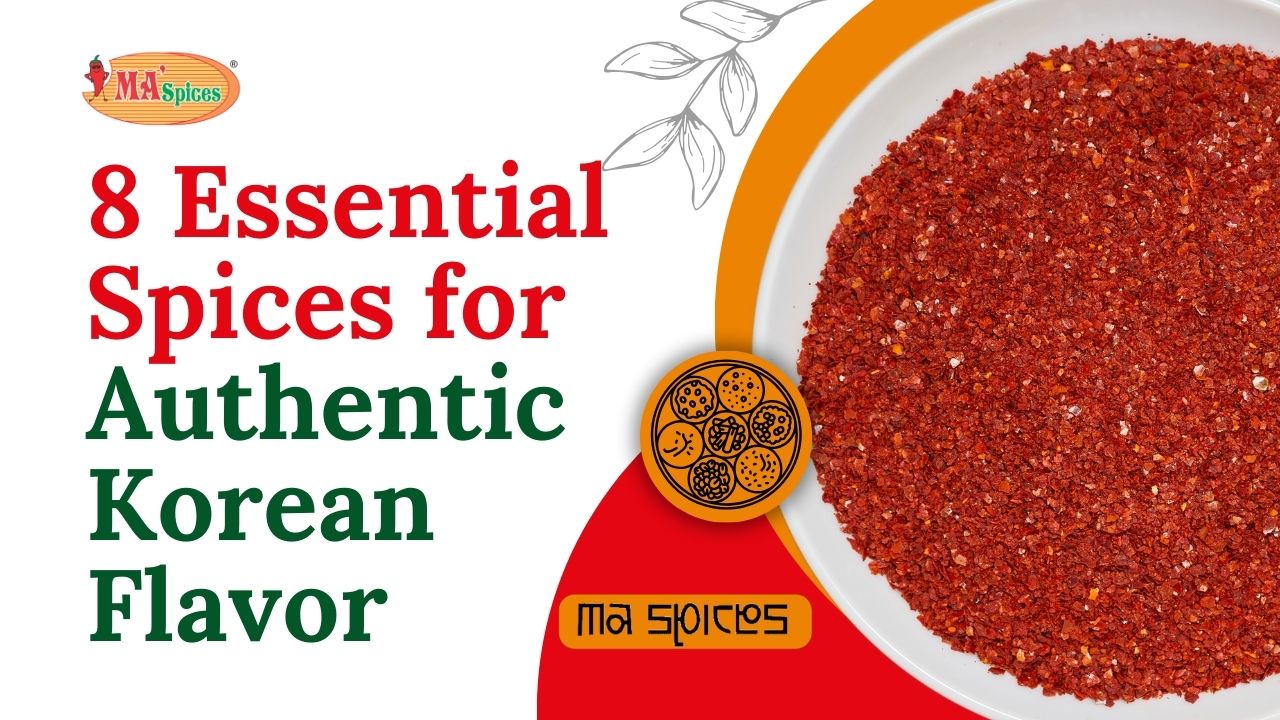Have you ever taken a bite of perfectly crispy Korean fried chicken glazed in sweet chili sauce and wondered how to replicate that addictive balance of flavors? Or dug into a steaming bibimbap, marveling at how every vegetal crunch and slippery noodle drenched in rich gochujang somehow works in harmony? The secret behind Korean cuisine’s compelling depth and diversity lies in a mastery of several key spices and ingredients that shape its unique flavor profiles. From the tongue-tingling heat of red pepper flakes to the nutty, toasted essence of sesame, and the salty funk of fermented soybean pastes – these 8 Korean spice essentials unlock the authentic flavors you crave…
Table of Contents
Toggle1)Gochugaru (Korean Chili Flake)
Ranging from mild and pleasantly warming to downright face-melting spicy, gochugaru flakes are the cornerstone of Korean cuisine’s signature heat. Crafted from sun-dried and crushed Korean red chilies meticulously seeded then sliced into delicate flakes, gochugaru permeates dishes like the nation’s iconic kimchi pickle with a distinctive depth and fruity, almost berry-like tone unlike any other Asian chili flake. Its complexity imbues stews, broths, meat marinades and vegetables with a pleasant, lingering burn that craves another bite.
2) Gochujang (Korean Chili Paste)
This thick, sticky fermented condiment lends a savory, subtly sweet miso-like backdrop capped with a craveable chili kick. Traditionally crafted from glutinous or sweet rice powder mixed with powdered fermented soybeans, salt and gochugaru red pepper flakes, then left to age in clay pots for years allowing complex flavors to emerge and meld. The paste’s mild fruitiness punctuated by occasional bursts of heat makes it as versatile as ketchup – pairing magically with proteins, noodles and vegetables alike.
3) Doenjang (Korean Soybean Paste)
This thick, sticky fermented condiment lends a savory, subtly sweet miso-like backdrop capped with a craveable chili kick. Traditionally crafted from glutinous or sweet rice powder mixed with powdered fermented soybeans, salt and gochugaru red pepper flakes, then left to age in clay pots for years allowing complex flavors to emerge and meld. The paste’s mild fruitiness punctuated by occasional bursts of heat makes it as versatile as ketchup – pairing magically with proteins, noodles and vegetables alike.
4) Toasted Sesame Oil
Unlike lighter Middle Eastern versions, Korean sesame oil skews towards the dark, rich and roasted end of the spectrum thanks to careful toasting of the seeds before cold pressing. This intensely aromatic, fragrant oil gets drizzled generously over everything from spinach salads to pan-seared vegetables and roasted meat proteins as a flavor finisher. Its captivating nuttiness sings at the forefront of any dish.
5)Toasted Sesame Seeds
No Korean meal is complete without these crispy, perfectly toasted white or black sesame seeds lending textural contrast and nutty richness to bowl meals and share plates alike. Their crunch enhances the flavor of even humble rice while their oils adhere to proteins and vegetables when tossed prior to cooking or sprinkled after as garnish. Crunchy, aromatic sesame is quintessentially Korean.
6) Korean Black Garlic
Black garlic may not be a “spice” per se, but these caramelized bulbs of garlic deserve prime real estate in Korean home kitchens and restaurants for the complexity they lend. Whole heads of garlic are aged via a month-long process of fermentation at high heat which brings out rich flavors reminiscent of balsamic, raisins and licorice capped with subtle sweetness. Black garlic’s distinctive jammy undertones enhance everything from fried rice to glazed meats.
7) Korean Black Pepper
Bolder, more floral and woodier compared to generic supermarket black pepper, Korea’s signature pepper hails exclusively from the nutrient-rich, volcanic soil of Jeju Island. To bring out robust flavor, the corns get washed, deseeded by hand then dried slowly before a final roast brings out aromatic oils. Fresh cracked Jeju pepper adorning grilled meats or finishing rich stews stands miles apart from regular black pepper, its lingering warmth begging for another taste.
8) Perilla
Last but certainly not least, these pleasantly minty yet licorice-like aromatic perilla leaves can be enjoyed fresh in salad or pickled as garnish and wrap. Their lingering coolness perfectly offsets spicy dishes while lending delicate citrus and herbaceous notes to balance heavier flavors. Beyond taste, the act of wrapping meat in a perilla leaf then presenting screams true Korean cuisine.
With mastery over these 8 essential Korean spices and ingredients, you hold the keys to unlocking authentic Korean flavors at home. It’s time to channel your inner Korean cook! Kick things up with spicy gochugaru heat, savor nutty sesame’s richness, dive deep into umami soybean funk then let perilla’s subtle chill balance it all out. The possibilities are mouthwateringly endless, so pull out your wok and gather that bibimbap bowl – your tastebuds are in for an adventure. MASpices offers an authentic Indian spice collection for bold, delicious flavors in your cooking.

